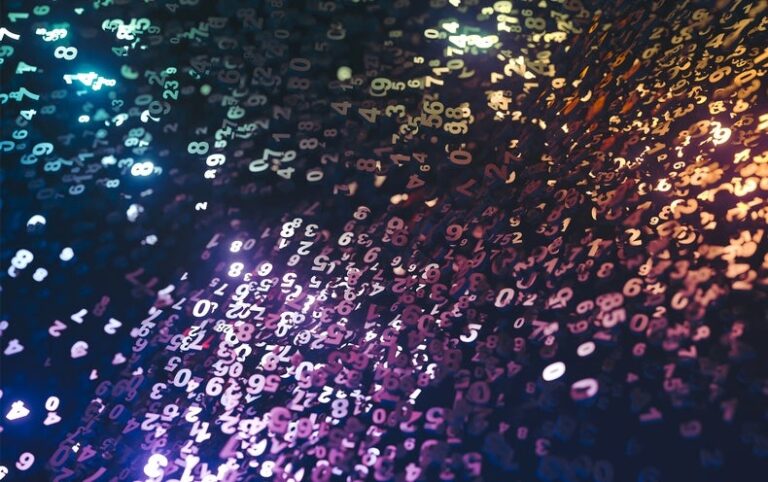
[ad_1]

What is your favorite number? Many people may have an irrational number in mind, such as pi (π), Euler’s number (e) or the square root of 2. But even among the natural numbers, you can find values that you encounter in a wide variety of contexts: the seven dwarfs, the seven deadly sins, 13 as an unlucky number—and 42, which was popularized by the novel The Hitchhiker’s Guide to the Galaxy by Douglas Adams.
What about a larger value such as 1,729? The number certainly doesn’t seem particularly exciting to most people. At first glance, it appears to be downright boring. After all, it is neither a prime number nor a power of 2 nor a square number. Nor do the digits follow any obvious pattern. That’s what mathematician Godfrey Harold Hardy (1877–1947) thought when he got into a cab with the identification number 1729. At the time, he was visiting his ailing colleague Srinivasa Ramanujan (1887–1920) in the hospital and told him about the “boring” cab number. He hoped it was not a bad omen. Ramanujan immediately contradicted his friend: “It is a very interesting number; it is the smallest number expressible as a sum of two cubes in two different ways.”
Now you may wonder if there can be any number at all that is not interesting. That question quickly leads to a paradox: if there really is a value n that has no exciting properties, then this very fact makes it special. But there is indeed a way to determine the interesting properties of a number in a fairly objective way—and to mathematicians’ great surprise, research in 2009 suggested that natural numbers (positive integers) divide into two sharply defined camps: exciting and boring values.
A comprehensive encyclopedia of number sequences provides a means for investigating these two opposing categories. Mathematician Neil Sloane had the idea for such a compilation in 1963, when he was writing his doctoral thesis. At that time, he had to calculate the height of values in a type of graph called a tree network and came across a sequence of numbers: 0, 1, 8, 78, 944,… He did not yet know how to calculate the numbers in this sequence exactly and would have liked to know whether his colleagues had already come across a similar sequence during their research. But unlike logarithms or formulas, there was no registry for sequences of numbers. And so, 10 years later, Sloane published his first encyclopedia, A Handbook of Integer Sequences, which contained about 2,400 sequences that also proved useful in making certain calculations. The book met with enormous approval: “There’s the Old Testament, the New Testament and the Handbook of Integer Sequences,” wrote one enthusiastic reader, according to Sloane.
In the years that followed, numerous submissions with more sequences reached Sloane, and scientific papers with new number sequences also appeared. In 1995 this prompted the mathematician, together with his colleague Simon Plouffe, to publish The Encyclopedia of Integer Sequences , which contained some 5,500 sequences. The content continued to grow unceasingly, but the Internet made it possible to control the flood of data: in 1996, the Online Encyclopedia of Integer Sequences (OEIS) appeared in a format unconstrained by any limitations on the number of sequences that could be recorded. As of March 2023, it contains just more than 360,000 entries. Submissions can be made by anyone: a person making an entry only needs to explain how the sequence was generated and why it is interesting, as well as provide examples explaining the first few terms. Reviewers then check the entry and publish it if it meets these criteria.
Besides well-known sequences such as the prime numbers (2, 3, 5, 7, 11,…), powers of 2 (2, 4, 8, 16, 32,…) or the Fibonacci sequence (1, 1, 2, 3, 5, 8, 13,…), the OEIS catalog also contains exotic examples such as the number of ways to build a stable tower from n two-by-four-studded Lego blocks, (1, 24, 1,560, 119,580, 10,166,403,…) or the “lazy caterer’s sequence” (1, 2, 4, 7, 11, 16, 22, 29,…), the maximum number of pie pieces that can be achieved by n cuts.
Because about 130 people review the submitted number sequences, and because the list with these obvious candidates has existed for several decades and is quite well known in the mathematics-savvy community, the collection is intended to be an objective selection of all sequences. This makes the OEIS catalog suitable for studying the popularity of numbers. Accordingly, the more often a number appears in the list, the more interesting it is.
At least, that was the thought of Philippe Guglielmetti, who runs the French-language blog Dr. Goulu. In one post, Guglielmetti recalled a former math teacher’s claim that 1,548 was an arbitrary number with no special property. This number actually appears 326 times in the OEIS catalog. One example: it shows up as an “eventual period of a single cell in rule 110 cellular automaton in a cyclic universe of width n.” Hardy was also wrong when he dubbed cab number 1729 as boring: 1,729 appears 918 times in the database (and also frequently on the TV show Futurama).
So Guglielmetti went in search of really boring numbers: those that hardly appear in the OEIS catalog, if at all. The latter is the case, for example, with the number 20,067. As of March, it is the smallest number that does not appear in any of the many stored number sequences. (This is just because the database stores only the first 180 or so characters of a number sequence, however—otherwise, every number would appear in the OEIS’s list of positive integers.) So the value 20,067 seems quite boring. By contrast, there are six entries for the number 20,068, which follows it.
But there is no universal law of boring numbers, and the status of 20,067 can change. Perhaps during the writing of this article, a new sequence has been discovered in which 20,067 appears among the first 180 characters. Nevertheless, the OEIS entries for a given number are suitable as a measure of how interesting that number is.
Guglielmetti went on to have the number of all entries output in sequence for the natural numbers and plotted the result graphically. He found a cloud of points in the form of a broad curve that slopes toward large values. This is not surprising insofar as only the first members of a sequence are stored in the OEIS catalog. What is surprising, however, is that the curve consists of two bands that are separated by a clearly visible gap. Thus, a natural number appears either particularly frequently or extremely rarely in the OEIS database.
Fascinated by this result, Guglielmetti turned to mathematician Jean-Paul Delahaye, who regularly writes popular science articles for Pour la Science, Scientific American’s French-language sister publication. He wanted to know if experts had already studied this phenomenon. This was not the case, so Delahaye took up the topic with his colleagues Nicolas Gauvrit and Hector Zenil and investigated it more closely. They used results from algorithmic information theory, which measures the complexity of an expression by the length of the shortest algorithm that describes the expression. For example, an arbitrary five-digit number such as 47,934 is more difficult to describe (“the sequence of digits 4, 7, 9, 3, 4”) than 16,384 (214). According to a theorem from information theory, numbers with many properties usually also have low complexity. That is, the values that appear frequently in the OEIS catalog are the most likely to be simple to describe. Delahaye, Gauvrit, and Zenil were able to show that information theory predicts a similar trajectory for the complexity of natural numbers as the one shown in Guglielmetti’s curve. But this does not explain the gaping hole in that curve, known as “Sloane’s gap,” after Neil Sloane.
The three mathematicians suggested that the gap arises from social factors such as a preference for certain numbers. To substantiate this, they ran what is known as a Monte Carlo simulation: they designed a function that maps natural numbers to natural numbers—and does so in such a way that small numbers are output more often than larger ones. The researchers put random values into the function and plotted the results according to their frequency. This produced a fuzzy, sloping curve similar to that of the data in the OEIS catalog. And just as with the information theory analysis, there is no trace of a gap.
To better understand how the gap occurs, one must look at which numbers fall into which band. For small values up to about 300, Sloane’s Gap is not very pronounced. Only for larger numbers does the gap open up significantly: about 18 percent of all numbers between 300 and 10,000 are in the “interesting” band, while the remaining 82 percent belong to the “boring” values. As it turns out, interesting band includes about 95.2 percent of all square numbers and 99.7 percent of prime numbers, as well as 39 percent of numbers with many prime factors. These three classes already account for nearly 88 percent of the interesting band. The remaining values have striking properties such as 1111 or the formulas 2n + 1 and 2n – 1, respectively.
According to information theory, the numbers that should be of particular interest are those that have low complexity, meaning they are easy to express. But if mathematicians consider certain values more exciting than others of equal complexity, this can lead to Sloane’s gap, as Delahaye, Gauvrit and Zenil argue. For example: 2n + 1 and 2n + 2 are equally complex from an information theory point of view, but only values of the first formula are in the “interesting band.” This is because such numbers allow prime numbers to be studied, which is why they appear in many different contexts.
So the split into interesting and boring numbers seems to stem from the judgments we make, such as attaching importance to prime numbers. If you want to give a really creative answer when asked what your favorite number is, you could bring up a number such as 20,067, which doesn’t yet have an entry in Sloane’s encyclopedia.
This article originally appeared in Spektrum der Wissenschaft and was reproduced with permission.
[ad_2]